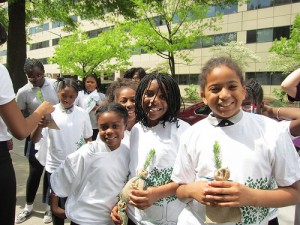- A tree can absorb as much as 48 pounds of carbon dioxide per year, and can sequester one ton of carbon dioxide by the time it reaches 40 years old. [1]
- One large tree can provide a supply of oxygen for two people. [2]
Energy
- According to the USDA Forest Service, “Trees properly placed around buildings can reduce air conditioning needs by 30 percent and save 20-50 percent in energy used for heating.” [3]
- The net cooling effect of a young, healthy tree is equivalent to ten room-size air conditioners operating 20 hours a day. [4]
Water
- In one day, one large tree can lift up to 100 gallons of water out of the ground and discharge it into the air. [5]
- For every five percent of tree cover added to a community, stormwater runoff is reduced by approximately two percent. [6]
Recreation and Wildlife
- Healthy trees provide wildlife habitat and contribute to the social and economic well-being of landowners and community residents. [7]

Plant A Tree For Education Fifth grade students from DC's Amidon Elementary School attended the planting and received free t-shirts and seedlings to plant at home.
EPA Urban Heat Island Effects [8]
- Reduced energy use: Trees and vegetation that directly shade buildings decrease demand for air conditioning.
- Improved air quality and lower greenhouse gas emissions: By reducing energy demand, trees and vegetation decrease the production of associated air pollution and greenhouse gas emissions. They also remove air pollutants and store and sequester carbon dioxide.
- Enhanced storm water management and water quality: Vegetation reduces runoff and improves water quality by absorbing and filtering rainwater.
- Reduced pavement maintenance: Tree shade can slow deterioration of street pavement, decreasing the amount of maintenance needed.
- Improved quality of life: Trees and vegetation provide aesthetic value, habitat for many species, and can reduce noise
Tree Lifespan
- A reasonable estimate of the lifetime of trees is 100-150 years. Based on information from the USDA Forest Service [9], the lifetime of trees varies by region and species, but generally ranges from 50 years to 300 years of age. An average lifetime of trees planted in forests for long-term restoration purposes might be 100-150 years. Here are a few examples by region
- In the Southeast, conifers may live 100-150 years, while hardwoods may live 150-200 years.
- In the northeast and lake states, some conifers (e.g. white pine and red pine) may live 100-150 years, while Jack pine lives 80-100 years; mixed hardwoods (e.g. maples and oaks) might live beyond 150 years, while aspen and birch might only live 50-70 years.
- In the Pacific Northwest, conifers may live 200-300 years and longer.


They used to say four air conditioners. I guess they've learned a few things since then.
ReplyDeleteI love trees. The Indians called them "the standing people". For the last 55 years, I have planted trees wherever I have lived and never tire of admiring their beauty. So....what about all the rain forests that are being destroyed? They give us oxygen and temper the climate. If, indeed, there is climate change, I would blame it on so many less trees.
ReplyDeleteI hear you Gorges. Four or ten, they are a big deal. Basic science, remember studying photosynthesis?
ReplyDeleteOhio has more trees than it did 100 years ago. The rain forest, yes that is a big deal.
I don't buy into the climate change panic but our habits have affected our environment. We love floating down a European river but have no desire to float down an American one. One is green, the other one is brown.
Ed